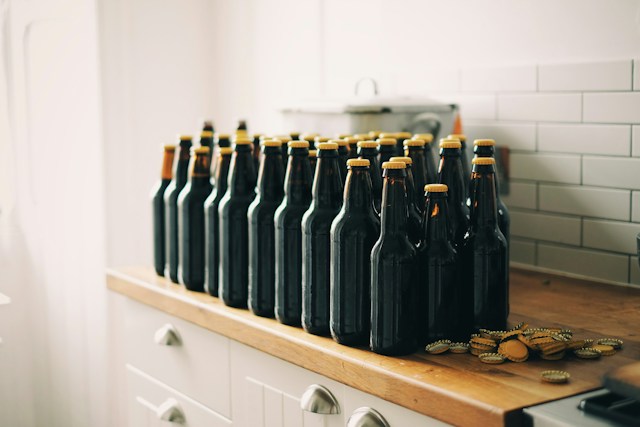
Beer Recipe
Ingredients:
- 8 lbs (3.6 kg) malt extract (liquid or dry)
- 1 lb (0.45 kg) specialty grains (e.g., caramel malt, chocolate malt)
- 1 oz (28 g) hops (bittering)
- 1 oz (28 g) hops (aroma)
- Yeast (liquid or dry) suitable for the style of beer you’re making
- Priming sugar (if bottling)
- Water
- Sanitizer for cleaning equipment
Equipment:
- Large stainless steel pot (at least 5 gallons)
- Fermentation vessel (glass carboy or plastic bucket)
- Airlock
- Thermometer
- Hydrometer (for measuring specific gravity)
- Siphoning equipment
- Bottles or keg (if bottling or kegging)
Instructions:
- Sanitize: Clean and sanitize all your equipment thoroughly to prevent contamination.
- Steep Grains: If using specialty grains, place them in a mesh bag and steep them in about 2.5 gallons (9.5 liters) of water heated to around 150-160°F (65-71°C) for 20-30 minutes. Remove the grains and discard.
- Boil: Bring the water to a boil, then remove it from the heat. Add the malt extract, stirring well to dissolve completely.
- Add Hops: Return the pot to the heat and bring it back to a boil. Once boiling, add the bittering hops and let them boil for about 60 minutes. Add the aroma hops in the last 5-15 minutes of the boil, depending on the desired intensity of hop aroma.
- Cool: After boiling, cool the wort quickly. You can do this by placing the pot in an ice bath in your sink or using a wort chiller until the temperature drops to around 70-75°F (21-24°C).
- Transfer to Fermenter: Transfer the cooled wort to your fermentation vessel. Top up with additional water to reach the desired volume, usually 5 gallons (19 liters).
- Pitch Yeast: Pitch your yeast into the wort according to the instructions on the yeast package. Seal the fermenter with an airlock filled with sanitizer to allow gases to escape while preventing contamination.
- Fermentation: Place the fermenter in a cool, dark place and allow fermentation to proceed. This typically takes 1-2 weeks, but can vary depending on the yeast strain and temperature.
- Bottling or Kegging: Once fermentation is complete, you can either bottle your beer by adding priming sugar to the beer before bottling to carbonate it naturally, or you can transfer it to a keg if you have kegging equipment.
- Conditioning: Whether bottling or kegging, your beer will need some time to carbonate and condition. Store it at room temperature for about 1-2 weeks, then refrigerate before serving.
